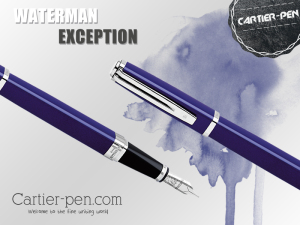If you are giving any product a name such as “Exception”, it better lived up to it. Waterman, sure knows how to do it.
Breaking away from the conventional rounded shape of a pen, Waterman went on to create a series of pen that is square in shape. Befittingly named Waterman Exception, the pen is a genius conception that has been brilliantly brought to life, despite the difficulties it might have faced in the making. It has definitely added a feather to Waterman’s hat, considering the immense skill and dedication it must have took.
The lacquer finish on the body gives a glossy, smooth effect to it. The end of the barrel has a blank platinum plated blind cap. A think platinum-plated barrel band has Waterman and France engraved on either side – a trademark in Waterman pens. The pull-off cap has cap has a luxurious platinum-plated trim too. The top of the cap has a round black lacquer medallion with the emblem “W” embedded on it. The silver plated clip is a classic Waterman clip with the slit in the middle. The pen weighs a total of 55gms with the 19gms owned by the cap alone. Hence, it is quite a labor to attach the cap to the barrel and write; an inconvenience for many.
Since the body is squarely shaped, the pen doesn’t have a section thread. Interestingly, they have introduced bayonet system, which cleverly does the job of keeping the barrel and the nib-part of the pen realigned. The nib on the fountain pen version is rhodium-plated, 18kt gold, yet quite flexible, wet and thus gives an easy, smooth writing experience. Then again, Waterman are known for their high-performing nibs. The grip on the pen is more rounded than the body, so there is no discomfort when writing.
The Exception series of Waterman comes in three different styles: Night and Day, Slim and Ideal. The former and the last of the Waterman are very similar, except that the former bears grey stripes on either side of squared plush body and the latter doesn’t. Both of these are available in fountain pen (medium and fine nib only) and rollerball versions only. The available colors are black and gold, and black and silver. Waterman Exception Slim, however, is available in rollerball, fountain and ballpoint version, with more color options to choose from. All in all, the Waterman Exception pen series is definitely a head turner and unique. All the versions available are high in performance and won’t let the writer down. And just like the pen which is pushing the boundaries in pen designing, it evokes the desire in the user too, to be more creative and out-of-the-box.
The brainchild of Lewis Edson Waterman, an insurance broker, the company’s first factory was set in 1883. Stories say that Waterman was so disgusted by the low quality of a pen on one occasion that he decided to develop a worthy fountain pen. And today, Waterman’s determination has truly been fruitful. You don’t have to look beyond Waterman Exception to know that.

